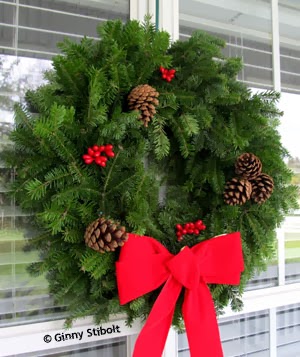Christmas is for the birds
My daughter sends a wreath to all the family members each year. They are perfectly fine wreaths that are part of a local fund raiser in her community. This year it is a full spruce wreath with a bow, some pinecones and plastic red berries that you can stick in the wreath--a product of Nova Scotia. I wrote about how I make my own wreaths in The Recycled Wreath to supplement her yearly gift.
And each year I feel bad for the small birds that are attracted to those fake berries. So this year I decided to take action and I added cranberry chains to both the original wreath and the recycled ones so the birds will find something to eat. The fake berries are still there, but they now hold up the cranberry chain. I also added various seed heads to the original wreath. So now all of my wreaths are bird-friendly. For more on making wreaths using native plants see Sue Dingwell's post from a few years back: Native plant wreath making.
If you don't have space for more trees in your landscape, you can still help the birds with your cut tree. After the holidays, instead of just leaving the tree for the county pickup, stand it in the back corner of your yard for the winter. Lean it against an inside corner of a fence, stake it in place, or tie it to the trunk of a tree. Just having the dense evergreen mass that birds can use for shelter during the cooler months will help them, but you can also add some food such as popcorn or cranberry chains, and peanut butter smeared pinecones.
If you do this each year, birds will learn to depend on this temporary habitat and food source. So after your celebration, help the birds survive.
By spring the tree will have lost its needles and then you can cut off the branches to use as a path or woodland mulch. The advantage of using it in a path, so the fragrance released when you walk on the fir or spruce. The trunk can be left in place as a snag or laid on the soil in an out-of-the-way place for use by bees and woodpeckers.
In the debate about which is greener: a cut tree or an artificial one, the recent research leans in favor of the cut trees. (See this article, Which Christmas tree is greener, real or artificial for the argument.)
For more information on building a bird-friendly habitat, see my post, Can the Birds Count on You?
Post and photos by Ginny Stibolt.
And each year I feel bad for the small birds that are attracted to those fake berries. So this year I decided to take action and I added cranberry chains to both the original wreath and the recycled ones so the birds will find something to eat. The fake berries are still there, but they now hold up the cranberry chain. I also added various seed heads to the original wreath. So now all of my wreaths are bird-friendly. For more on making wreaths using native plants see Sue Dingwell's post from a few years back: Native plant wreath making.
 |
 |
| Original wreath | So this is what it looks like now. |
 |
| The eastern red cedar (Juniperus virginiana) makes a great Christmas tree and is an important habitat tree. |
O Christmas Tree
As for your other holiday décor, we hope that you've been purchasing live trees each year so that you now have a thicket or hedgerow of native evergreens to enhance the habitat value of your yard. The birds would love you for this. In colder regions of the country buying live trees is problematic because of frozen soil and harsh winter conditions, but here in Florida, January is a great time for planting trees. Just be sure to supply enough irrigation, because it is the middle of our dry season. See my article Trees and Shrubs: the Bones of your Landscape for planting and irrigation guidelines. |
| After the holidays, cut trees can still offer winter habitat for your birds. |
If you do this each year, birds will learn to depend on this temporary habitat and food source. So after your celebration, help the birds survive.
By spring the tree will have lost its needles and then you can cut off the branches to use as a path or woodland mulch. The advantage of using it in a path, so the fragrance released when you walk on the fir or spruce. The trunk can be left in place as a snag or laid on the soil in an out-of-the-way place for use by bees and woodpeckers.
In the debate about which is greener: a cut tree or an artificial one, the recent research leans in favor of the cut trees. (See this article, Which Christmas tree is greener, real or artificial for the argument.)
For more information on building a bird-friendly habitat, see my post, Can the Birds Count on You?
 |
| I wish you a merry holiday filled with family and fun. |



Comments